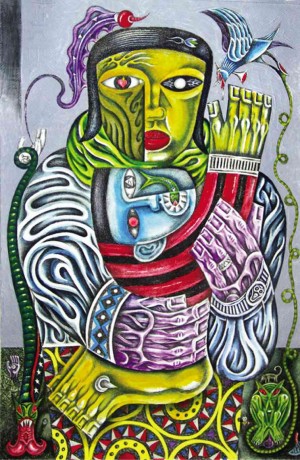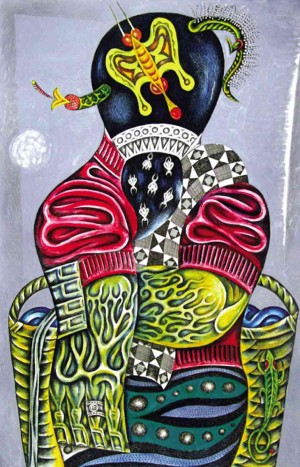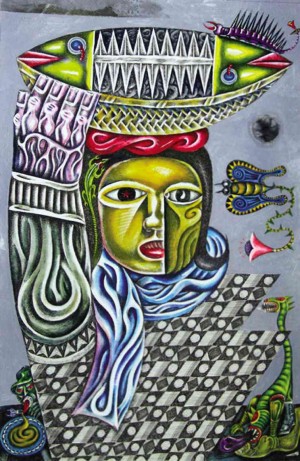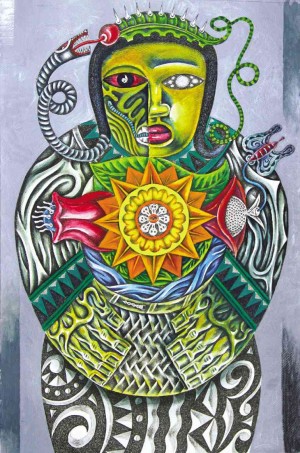
The art of Nunelucio Alvarado is among the few instantly recognizable in Philippine contemporary art. Its most consistent, unerring trademark is the stark frontality of all his figures, recalling Egyptian paintings with their hieratic presentation of bodies and faces.
One would think that such a straightjacket format would constrain the artist, limit the exploration of his themes, and restrain the impact and power of his images. Remarkably, this manner of presentation has persisted since the mid-1960s when Alvarado first emerged on the art scene.
He was one of the Social Realists who banded together, known as the Kaisahan group, among whom were Edgar Fernandez, Neil Doloricon and Renato Habulan. They were united by a single voice that decried the social injustice and miserable poverty which stalked the country.
Born in 1980, in Barangay Fabrica, Sagay, Negros Occidental, earning an Arts degree in Bacolod in 1968, thence studying painting at the University of the Philippines College of Fine Arts, Alvarado has been a full-time painter for over four decades. He has raised his family on the proceeds of his art, necessarily with many sacrifices along the way.
Today he is patriarch of a family which counts, among his progeny, several artists, who must, one fears, constantly struggle to assert their art, away from the looming shadow cast by their father.

Alvarado found the subject he was born to paint right in the very place where he first saw light. In a history of hardship that was Negros Occidental, Alvarado awakened to the most wounding irony: a land that was singularly reserved for the monocrop of sugarcane.
The eminent critic Alice Guillermo, writing about the art of Alvarado, titled her essay “Sugar Is Bitter.” A panorama of countless canvases has portrayed peasants indebted, from birth to death, to the ruling class. His works are compellingly created, driven by a cause that goes beyond superficial aesthetics, flung into regions of rage and despair that will not be silenced.
New show at Anna
For these recent works, Alvarado has considerably eased up the tension in his conflict-ridden themes. The artist has billed this show at Galerie Anna simply as “Babaye” (Woman)—an hommage to the Visayan woman endearingly called “Inday.”
But the show is not Alvarado’s capitulation to the sun-drenched dalagangbukid of Fernando Amorsolo. Not for Alvarado is “the visual construct of a tropical Eden of bountiful harvests and comely women in a projection of the Orientalist world view,” wrote Guillermo.

Despite the ostensibly charming subject, the works are affected by an undercurrent of unrest. To be sure, the women are invested with the classic Alvarado look: a fiercely delineated stance, reminiscent of woodcuts, evident in the black outlines of the figures.
(Whether the so-called “Angry Christ” painted by Alfonso Ossorio for a chapel inside Victorias, Negros Occidental sugar mills had any profound subconscious influence on Alvarado’s style is not a far-fetched matter of conjecture. Ossorio, a scion of sugar barons, emigrated to the US in the ’50s, and became close friends with the Abstract Expressionist Jackson Pollock and his wife Lee Krasner.)
Indeed, the female figures may, at first glance, be misconstrued as male workers, so massive is the built, so aggressive is the posture.
Symbol-laden
All the works are symbol-laden, from the mask-like visages that have been divided into two to reveal the woman’s internal self, those eyes embedded with orbs glistening with satirical insights. The musculature of arms, limbs and extremities appears as if flesh had been exposed, skinned down to skeletal structure.
The artist’s trademark spikes, thorns, sharply jagged lines, and serrated edges are abundantly deployed in crowns of thorns and a spread of fish arrayed on woven native baskets that are themselves marvels of repeated patterning.
Interestingly Alvarado has lit on sheer ornamentation which seems to have emerged effortlessly, or at least, organically. The feathered chicken wings in “Ihaw” are like forms and foliage in their efflorescence. Animate creatures spring out from vein-like tunnels. Lizards, with knife-like tongues, and slithering serpentine creatures surprisingly flash like icons in unforeseen places.

From the titles alone the viewer can glean a malevolent presence, like a worm curling out of the fruit: “Itlog Baog,” “Toxic,” “Kontaminado’” and “Tentasyon.”
There are stray male figures such as “Mamang Inasal,” if only to remind us of the origin of the famous roasted chicken.
Do not, however, look forward soon to the merry-making street revelry of Masskara. If, and when, it does make its appearance in Alvarado’s art, the viewer can be sure that the work will be laced with an unexpected caustic message, as only a true-blue Social Realist like Alvarado can envision.
“Babaye” is Alvarado at his gentlest, amorous self, more willing and open-hearted, more accepting of the harsh realities of his land and people.
As if to make a point, there is a painting titled “Shy Girl,” faceless, for she has her back turned to us, depicting a lass whose heart has to be wooed and won.
Even from an artist known for his tough, unrelenting art, this display of tenderness from Nune Alvarado catches us by surprise.













































